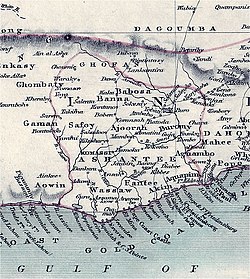Kingdom of Ashanti
| Kingdom of Ashanti | ||||||||||||||
| the Ashanti Kingdom (Ashanti) | ||||||||||||||
| State union | ||||||||||||||
|
||||||||||||||
|
||||||||||||||
|
Map of the Kingdom of Ashanti
|
||||||||||||||
| Capital |
|
|||||||||||||
| Languages | Ashanti (Twi) (official) | |||||||||||||
| Religion | Ashanti (Akan religion) | |||||||||||||
| Government | Monarchy | |||||||||||||
| King | ||||||||||||||
| • | 1670–1717 (first king) | Osei Tutu | ||||||||||||
| • | 1888–1896 (13th king of the indep. Ashanti Kingdom) | Prempeh I | ||||||||||||
| • | 1931–1957 (last king of the indep. Ashanti Kingdom) | Prempeh II | ||||||||||||
| • | 1999–present (Ashanti region absolute monarchy national state within Ghana) | Osei Tutu II | ||||||||||||
| Legislature | Asante Kotoko (Council of Kumasi) & the Ashanti Kingdomhyiamu (National Assembly) | |||||||||||||
| History | ||||||||||||||
| • | Established | 1670 | ||||||||||||
| • | Independence from Denkyira | 1701 | ||||||||||||
| • | British protectorate | 1896 | ||||||||||||
| • | Self-Rule | 1935 | ||||||||||||
| • | State union as Ashanti Region with Ghana | 1957 | ||||||||||||
| • | State union | Present | ||||||||||||
| Area | ||||||||||||||
| • | 1874 | 259,000 km² (100,000 sq mi) | ||||||||||||
| Population | ||||||||||||||
| • | 1874 est. | 3,000,000 | ||||||||||||
| Density | 11.6 /km² (30 /sq mi) | |||||||||||||
| Currency | ||||||||||||||
|
||||||||||||||
| Today part of |
|
|||||||||||||
The Ashanti (also spelled Asante) Empire (1701–1957) was an Akan empire and kingdom in what is now modern-day Ghana. The Ashanti Empire expanded from Ashanti to include the Brong-Ahafo, Central region, Eastern region, Greater Accra region, and Western region, of present-day Ghana. The Ashanti benefited from early firearm adoption. Combined with effective strategy, they fashioned an empire that stretched from central Ghana to the present-day Ivory Coast. Due to the empire's military prowess, wealth, architecture, sophisticated hierarchy and culture, Ashanti has been extensively studied and has more historiographies by European, primarily British, authors than almost any other indigenous culture of Sub-Saharan Africa.
Starting in the late 17th century, the Ashanti king Osei Tutu (c. 1695 – 1717) and his advisor Okomfo Anokye, established the Ashanti Kingdom, with the Golden Stool of Asante as a sole unifying symbol. Osei Tutu oversaw a massive Ashanti territorial expansion, building up the army by introducing new organization and turning a disciplined royal and paramilitary army into an effective fighting machine. In 1701, the Ashanti army conquered Denkyira, giving the Ashanti access to the Gulf of Guinea and the Atlantic Ocean coastal trade with Europeans, notably the Dutch.
The Ashanti Kingdom is the home to Lake Bosumtwi, Ghana's only natural lake. The state's current economic revenue is derived mainly from trading in gold bars, cocoa, kola nuts and agriculture; forest has also been cleared to plant cassava, maize and yams.
...
Wikipedia



